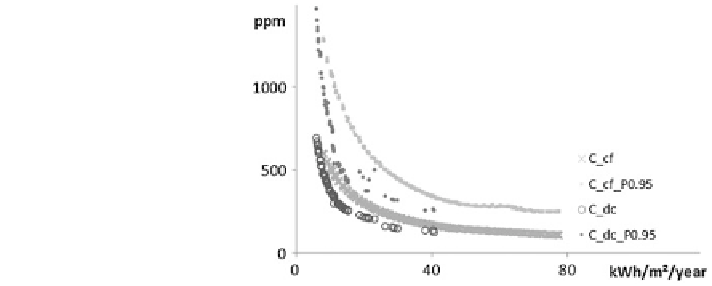Civil Engineering Reference
In-Depth Information
Fig. 9 Pareto optimal mean
exposure (ppm) versus
ventilation heat loss (kWh/
m
2
/year) in a Belgian
detached house for
continuous flow (C_cf) and
demand-controlled (C_dc)
exhaust ventilation, with
associated peak exposures
(P
0.95
)
2003
, Shan et al.
2012
) and schools (Wachenfeldt et al.
2007
). In each of these
settings, a considerable ventilation heat loss reduction potential (20-50 %) was
reported.
Hybrid ventilation adopts the same strategy to reduce fan energy: fans are only
operated if available natural driving forces are insufficient to provide the required
ventilation flow rate (Delsante and Aggerholm
2002
; Dorer et al.
2005
). The latter
can of course be demand modulated, combining hybrid fan technology with tra-
ditional demand control (Op't Veld
2008
).
5 Conclusions
In this chapter, we have first discussed the possible effects of exposure to airborne
pollutants. Health effects from specific pollutants with common indoor sources
include increased prevalence of cancer, cardiovascular disease and asthma as well
as a long list of acute symptoms. Subsequently, ventilation was discussed as one of
the possible risk management strategies to minimize these effects. The perfor-
mance of ventilation system approaches was presented as a trade-off between
ventilation heat loss and effect minimization. The energy-saving potential of heat
recovery by air-to-air heat exchangers as well as demand control in Western
Europe was shown to be around 50 %.
References
Abbassi R, Dadashzadeh M, Khan F et al (2012) Risk-based prioritisation of indoor air pollution
monitoring using computational fluid dynamics. Indoor Built Environ 21:663-673
Amato F, Pandolfi M, Moreno T et al (2011) Sources and variability of inhalable road dust
particles in three European cities. Atmos Environ 45:6777-6787
Andersen RK, Olesen BW, Toftum J (2011) Modeling window opening behaviour in Danish
dwellings. Indoor Air Austin

